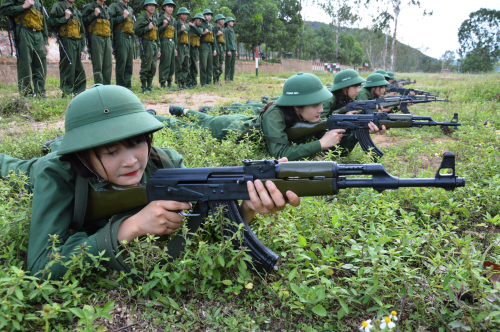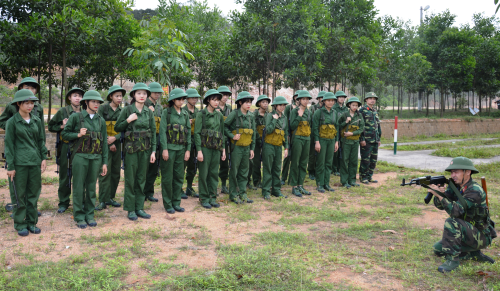Military School of Military Region 3 improves the quality of defence and security education
The Military School of Military Region 3 (MR3) is tasked with training non-commissioned commanding officers, technically-specialised staff, reserve officers, etc., meeting the demands for building MR3’s armed forces; at the same time, conducting defence and security training to the 2, 3, 4-class cadres of the localities, and students in colleges and universities assigned by the Defence Ministry. In recent years, to meet the high demands for the task of education and training, the School has received much concern and investment to build and develop in many ways; especially in 2021, the Defence and Security Education Centre of the School was renovated, making it favourable for the School to improve the capacity and quality of defence and security education. However, from the new requirements of the defence and security education in the new situation, the School has encountered various difficulties and challenges, including the limited supply of training materials and facilities, the insufficiency in cadres and lecturers, the diversity of learners, the fluctuations in the number of students. In this situation, the School Party Committee and Board have made their leadership and direction on implementing many solutions to overcome difficulties, being determined to successfully accomplish this task.
 |
| Students conduct shooting training |
First and foremost, strengthening the leadership and direction of all-level party committees and commands, and bringing into play the roles of the Defence and Security Education Centre. Thoroughly grasping the resolutions and directives of the Party, Government and the circulars and instructions of the Ministry of National Defence, Ministry of Education and Training on the defence and security education, especially the plans and guidelines of MR3’s Defence and Security Education Council, the School has proactively coordinated with MR3’s functional offices and the military commands in provinces to confirm the number of learners; at the same time, it has held various joint conferences with other schools to grasp the situation, confirm the training time and numbers of students, on this basis, building plans to submit for MR3’s approval, brief tasks to related offices and units. The School has also directed the Defence and Security Education Centre, faculties and offices to build their specialised resolutions, plans, instructions and coordination for the synchronous and practical implementation.
In order to overcome the difficulties caused by the insufficiency in personnel and facility, together with the ongoing renovation of the Defence and Security Education Centre, the School has directed the Training Department and the Defence and Security Education Centre to research, integrate and optimise the training schedules and programmes for the military learners with the schedules of defence and security education and training, creating the favourable conditions for cadres and lecturers to do their tasks. Besides, the School has intensely directed offices and units to proactively prepare enough accommodation for all learners to stay in the School during their courses.
Given the diversity of learners, especially the 2-class cadres who are heads of local departments, branches, etc., with high level of expertise, good awareness and experience in leadership and management, the School chooses suitable lecturers to conduct training. Accordingly, the School has selected and built the contingent of specialised lecturers, consisting of the School Board, heads of its offices and faculties, departments and the highly-skilled and experienced cadres to conduct training for learners who are class-2 and 3 cadres. Especially, for some specific courses, the School invites leaders of MR3, provinces and cities, commanders of the Police and Border Guard in the area to give lectures and guest talks. For students, the School selects young, motivated, highly skilled lecturers; and appoints experienced cadres as “the second teachers”.
In order to improve the competence of lecturers, meeting the requirements of the defence and security education in the current period, the School enhances training, closely combines the selection of lecturers to be trained due to the seniors’ schedules with on-the-job training. Based on the training contents from the seniors, the School holds extended training; regularly organises the contest of good cadres and lecturers at all levels in order to evaluate their quality and create motivations for them to conduct self-study and self-research to improve their competence. Besides, the School proactively proposes MR3 to send their cadres and lecturers on fieldtrips to other units and localities to upgrade their knowledge and accumulate experience. With the above practical and effective solutions, 100% of lecturers of defence and security education in the School have gained university degrees and above; 30% of them have acquired master degrees, and 6% of them have worked in regiment-level units. They are core forces, making an important contribution to the School’s improvement of quality of the education and training in general, the defence and security education in particular.
 |
| Drill modelling for students |
Together, the School intensely reforms the teaching-learning contents and methods, making it relevant to the learners and reality. Closely following the regulated framework programme, guidelines and directions of MR3’s Defence and Security Education Council, the School has researched and built the contents based on the system of specialised subjects, making them suitable to each learner and practical to MR3’s features and tasks of defence and security, focusing on removing the unsuitable contents and updating newer ones on the Party’s military and defence guidelines; practical experience in leading and directing the military and defence work in the localities, etc.
Due to the short training time plus the large amount of knowledge, in order to gain the defined goals and requirements, the School directs faculties and the Centre to pay attention to harmoniously combining between the traditional teaching methods with modern ones, considering learners as the centre in order to make the most of their positiveness and activeness in learning. In each lesson, the School requires lecturers to take full advantage of information technology, flexibly integrate and utilise various methods, including presentation, group discussion, observation, etc. to assist learners in acquiring general and in-depth knowledge, and applying theories into reality. Specifically, for the 2 and 3-class cadres, the School applies the “group problem-solving” method. Accordingly, lecturers raise issues of current affairs, link to the real military and defence tasks of the localities and MR3 for learners to research, exchange, discuss, and suggest solutions based on different working positions, therefore helping them develop their critical thinking and share their real experience. Lecturers, then, make summaries and orient the general awareness, assuring the unity and the possibility of applying into the real tasks.
To maintain and improve the quality of defence and security education, together with enhancing the supervision, inspection, investment and reconstruction of the Defence and Security Education Centre, the Schools pays attention to fully making use of the existing materials and facilities, bringing into play the advantage of the military environment in conducting this task. On closely following the training programmes and schedules for all learners, especially those of the military, the School directs the Centre to collaboratively utilise the system of classrooms and training grounds in a scientific and suitable way without any overlap, especially the grounds for general physical training and for infantry combat techniques; fully exploit the functions of the simulation room, MBT-03 firing facilities, teaching aids, etc. Together, the School takes full advantage of the available military environment, allowing for students to observe the training and regulation maintenance of military cadets, for the 2 and 3-class cadres to visit the operation of defence zones in defence situations which is included in the training programmes in the intensive training area of the School. This, as a result, has created favourable conditions for its learners to approach the real situations, directly supporting their learning and training at the school.
By means of these active, synchronous and suitable solutions, for the past 4 years, the School has conducted defence and security training to 1,833 cadres of all types and to over 14,000 students; 100% of them have been rated satisfactory, over 90% being good and excellent. This result has been highly appreciated by MR3 and schools.
Bringing into play the achieved experience and results, in the coming time, the School’s Party Committee and Board will accelerate the review and completion of the Project on Building MR3’s Defence and Security Education Centre and submit for approval from all levels. In particular, it will focus on researching and suggesting plans of building all construction categories and facilities for managing, operating and teaching in the modern and dual-purpose directions, etc., assuring all the conditions needed for daily activities and learning of cadets, students, cadres and teachers, meeting the demands of the defence and security training task. Moreover, it will strengthen the coordination with MR3’s functional offices, schools and units, and the local governments to exchange information and conduct experience gaining activities, making contribution to continuously improving the quality of defence and security education, and meeting the task requirements in the new situation.
Senior Colonel TRAN VAN TU, The School Rector